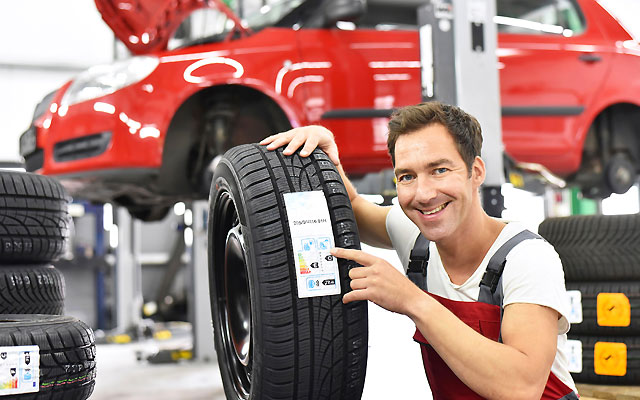Similar to the energy labels on domestic appliances like fridges and washing machines, new tyres have to carry a label giving you information about their performance; wet grip, fuel efficiency and noise.
The same information also appears on websites selling tyres.
The label's the result of a European regulation aimed at reducing fuel consumption by helping drivers make better choices when they buy tyres.

While the information on the label is important it doesn’t tell you much about a tyre's overall performance and doesn't include any information about characteristics such as:
- Tyre life
- Dry road braking and handling
- Wet road handling and aquaplaning
- Comfort/ride quality
It’s best to ask your tyre supplier for advice or check independent tyre tests.
We provide 24/7 roadside assistance.
Fuel consumption
Overall your tyres’ rolling resistance accounts for about 15% of your overall fuel consumption.
How your tyres effect your fuel costs depends on what you buy and how you look after them:
- Most tyre manufacturers now include energy saving tyres in their range. These have a lower rolling resistance, so should give you better fuel economy, without seriously affecting ride comfort or grip.
- For any given tyre, lower pressure means more rolling resistance and higher fuel consumption.
Fuel efficiency (rolling resistance)
- The label shows the tyre's fuel efficiency on a sliding scale from A (best) to G (worst).
- The difference between best and worst can be as much as 7.5% for cars.
Wet grip
Reducing rolling resistance too far can increase braking distances, particularly in the wet, so to maintain safety the label covers wet grip too.
- Wet grip performance is measured under controlled conditions and rated from A (best) to G (worst).
- The difference in stopping distance between each grade will be one or two car lengths when braking from 50mph.
- Overall the difference in braking distance between best and worst (A to G) will be around 30%.
Noise
Tyres also affect the environment because of the exterior noise they generate.
To reduce noise pollution tyre manufacturers must comply with increasingly stringent maximum noise limits, and the bottom part of the label shows the exterior noise level, measured in decibels (dB) and a pictogram with up to three ‘sound waves’ to indicate relative performance:
- A single 'sound wave' shows that the tyre is relatively quiet
- Three 'sound waves' shows that the tyre is relatively noisy
3 February 2017
